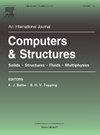Mesoscale modelling of single-aggregate debonding behaviour in asphalt pavement using the combined finite and discrete element method
IF 4.4
2区 工程技术
Q1 COMPUTER SCIENCE, INTERDISCIPLINARY APPLICATIONS
引用次数: 0
Abstract
Aggregate loss from artificial asphalt pavement surfaces widely happens, which causes premature deterioration of roads. However, the debonding mechanism of geographical aggregate is still unrevealed owing to the intricate aggregate morphology and the multiphase structure. To address this challenge, a combined finite and discrete element method (FDEM) was presented to simulate the debonding behaviour in the mesoscale. A mesh-size sensitivity study was first conducted on the asphalt composite to ensure the model self-consistency. Then a realistic particle shape with natural morphology from X-ray micro-computed tomography (XCT) was imported into the numerical model. To explore the role of the aggregate shape on debonding behaviour, systematic simulations were also performed on spherical, ellipsoidal particles for comparison. Results show that the curvature variation could significantly enhance the nesting effect, facilitating stress diffusion. Meanwhile, the further enrichment of irregular curvature variation on real particles results in a more uniform distribution of failure area concerning the aggregate and interface, however, reduces the maximum reaction moment for debonding. The breaking moments for both ellipsoidal and realistic aggregates obey the Generalized extreme value (GEV) distribution. This study helps improve the cognition of aggregate shape effect on debonding behaviour and facilitates the design optimization of the asphalt wearing course.
沥青路面单集料脱粘行为的中尺度有限元与离散元联合模拟
人工沥青路面普遍存在集料流失现象,导致路面过早老化。然而,由于地理聚集体形态复杂,结构多相,其脱粘机理尚不清楚。为了解决这一挑战,提出了一种结合有限元和离散元的方法(FDEM)来模拟中尺度的脱粘行为。为了保证模型的自一致性,首先对沥青复合材料进行了网格尺寸敏感性研究。然后将x射线微计算机断层扫描(XCT)获得的具有自然形态的真实粒子形状导入数值模型。为了探索聚集体形状对脱粘行为的作用,还对球形和椭球状粒子进行了系统模拟以进行比较。结果表明,曲率变化能显著增强嵌套效果,有利于应力扩散。同时,真实颗粒上不规则曲率变化的进一步富集,使得团聚体和界面的破坏区域分布更加均匀,但最大脱粘反应矩减小。椭球体和真实集料的断裂矩均服从广义极值分布。本研究有助于提高对骨料形状对沥青脱粘行为影响的认识,有利于沥青磨损过程的设计优化。
本文章由计算机程序翻译,如有差异,请以英文原文为准。
求助全文
约1分钟内获得全文
求助全文
来源期刊

Computers & Structures
工程技术-工程:土木
CiteScore
8.80
自引率
6.40%
发文量
122
审稿时长
33 days
期刊介绍:
Computers & Structures publishes advances in the development and use of computational methods for the solution of problems in engineering and the sciences. The range of appropriate contributions is wide, and includes papers on establishing appropriate mathematical models and their numerical solution in all areas of mechanics. The journal also includes articles that present a substantial review of a field in the topics of the journal.
 求助内容:
求助内容: 应助结果提醒方式:
应助结果提醒方式:


